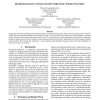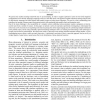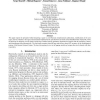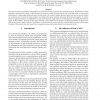LREC
2008
14 years 1 months ago
2008
In this paper we deal with a recently developed large Czech MWE database containing at the moment 160 000 MWEs (treated as lexical units). It was compiled from various resources s...
LREC
2008
14 years 1 months ago
2008
This paper presents the automatic extension of Princeton WordNet with Named Entities (NEs). This new resource is called Named Entity WordNet. Our method maps the noun is-a hierarc...
LREC
2008
14 years 1 months ago
2008
The project presented here is a part of a long term research program aiming at a full lexicon grammar for Polish (SyntLex). The main concern of this project is computer-assisted a...
LREC
2008
14 years 1 months ago
2008
Linguists have long been producing grammatical decriptions of yet undescribed languages. This is a time-consuming process, which has already adapted to improved technology for rec...
LREC
2008
14 years 1 months ago
2008
In this paper we discuss how linguistic and geographic distances can be related using a 3D visualization. We will convert linguistic data for locations along the German-Dutch bord...
LREC
2008
14 years 1 months ago
2008
The paper will give an overview of developments in Estonia in the field of Human Language Technologies. Despite of the fact that Estonian is one of the smallest official languages...
LREC
2008
14 years 1 months ago
2008
We present the machine learning framework that we are developing, in order to support explorative search for non-trivial linguistic configurations in low-density languages (langua...
LREC
2008
14 years 1 months ago
2008
Texts generated by automatic speech recognition (ASR) systems have some specificities, related to the idiosyncrasies of oral productions or the principles of ASR systems, that mak...
LREC
2008
14 years 1 months ago
2008
This paper reports the principles behind designing a tagset to cover Russian morphosyntactic phenomena, modifications of the core tagset, and its evaluation. The tagset and associ...
LREC
2008
14 years 1 months ago
2008
This paper focuses on the influence of changing the text time frame on the performance of a named entity tagger. We followed a twofold approach to investigate this subject: on the...




